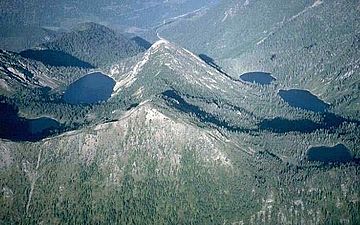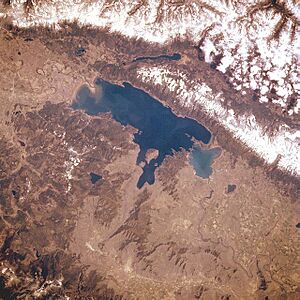Swan Range facts for kids
Quick facts for kids Swan Range |
|
|---|---|

The Jewel Basin part of the Swan Range
|
|
| Highest point | |
| Peak | 9,356 feet (2,852 m) (Holland Peak) |
| Dimensions | |
| Length | 91 mi (146 km) north-south |
| Width | 66 mi (106 km) east-west |
| Area | 1,961 km2 (757 sq mi) |
| Naming | |
| Etymology | Named for Emmett Swan or named for trumpeter swans on Swan Lake |
| Geography | |
| Country | United States |
| Settlements | Kalispell and Bigfork |
| Range coordinates | 47°43.5′N 113°37.6′W / 47.7250°N 113.6267°W |
The Swan Range is a long mountain range located in western Montana, a state in the United States. These mountains are known for their beautiful peaks, which usually reach heights of about 8,000 to 9,000 feet (2,400 to 2,700 meters). The Swan Range forms a natural boundary between several important rivers and areas. To its east is the South Fork Flathead River, while the Flathead River lies to the north and northwest. The Swan River runs along its western side. This mountain range is also located just southwest of Glacier National Park and not far from the border with Canada. It stretches for about 99 miles (159 kilometers) from north to south. Cities like Kalispell, Bigfork, and Seeley Lake are found near the Swan Range.
Contents
What's in a Name? The Swan Range's Story
The Swan Range shares its name with Swan Lake and the 93-mile (149-kilometer) long Swan River, which flows north on the west side of the mountains. There are a couple of ideas about how the name came to be. One idea is that it was named after trumpeter swans. These large, beautiful birds used to live on Swan Lake, though they are not found there today. Another possibility is that the river, the lake, and the mountain range were all named after Emmett Swan, who lived in the Swan Valley for a long time.
Exploring the Geography of the Swan Range
The Swan Range is part of a larger group of mountains called the Kootenay Mountains. It has neighbors too! To its west, you'll find the smaller Mission Range. To the east and northeast, there's the Flathead Range, which is similar in size. The Swan Range itself is about 99 miles (159 kilometers) long from north to south and about 66 miles (106 kilometers) wide from east to west.
Highest Points in the Swan Range
The tallest peak in the Swan Range is Holland Peak, which stands at 9,356 feet (2,852 meters) high. It's located in the southern part of the range in Missoula County. Many streams flow down the east side of the Swan Range, and their water eventually drains into the 98-mile (158-kilometer) long South Fork Flathead River.
A large body of water called the Hungry Horse Reservoir is located to the northeast of the range. This reservoir was created by building a dam on the South Fork of the Flathead River. In the north, a place called Badrock Canyon, where the Flathead River flows, separates the Swan Range from the Whitefish Range. All the water from the Swan Range eventually makes its way to the Pend Oreille River drainage basin, and then into the mighty Columbia River.
Rivers and Lakes Near the Swan Range
The Swan River forms a big part of the western border of the Swan Range. It flows through a wide valley that lies between the Swan and Mission ranges. To the west of the Swan Range, you'll find Flathead Lake. This is the second-largest freshwater lake in the western United States! The Mission Range separates Flathead Lake from the Swan Range.
The boundary between the Swan Range and the Flathead Range becomes less clear as you go further south. It's in the middle and northern parts of the range where this boundary is most noticeable. Many of the valleys that cut through the Swan Range send their water into the South Fork of the Flathead River. This means that the main water divide of the range is located more towards the west.
While most people say the Swan Range peaks reach about 9,000 feet (2,700 meters), some older maps and the National Geographic Society once listed Swan Peak (the second-highest mountain) as being around 11,000 feet (3,400 meters). They even said it was the highest mountain! One old description said, "The range to the east of [the Swan River valley] is the Swan Range. It is the highest and least broken ridge in the region, the higher peaks rising to ten and eleven thousand feet."
Towns and Activities Around the Swan Range
If you travel from north to south, some of the towns and cities that border the Swan Range include Columbia Falls, La Salle, Creston, Bigfork, Seeley Lake, and Lincoln. The southern part of the range is a wild area known as the Bob Marshall Wilderness. The eastern side of the range is mostly undeveloped, meaning it's still very natural and wild. However, the western side is used for some ranching, and Montana Highway 83 runs right alongside it.
The Five Tallest Peaks in the Swan Range
Here are the five highest mountains in the Swan Range:
| Name | Height | Prominence |
|---|---|---|
| Holland Peak | 9,356 feet (2,852 m) | 4,036 feet (1,230 m) |
| Swan Peak | 9,289 feet (2,831 m) | 2,329 feet (710 m) |
| Ptarmigan Benchmark | 9,083 feet (2,768 m) | 2,483 feet (757 m) |
| Goat Mountain | 8,845 feet (2,696 m) | 1,765 feet (538 m) |
| Cardinal Peak | 8,582 feet (2,616 m) | 1,342 feet (409 m) |
Images for kids



